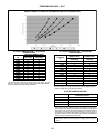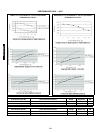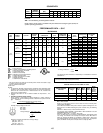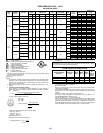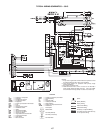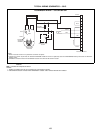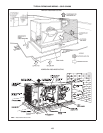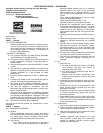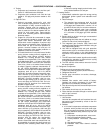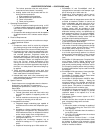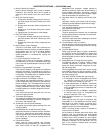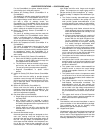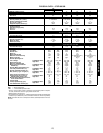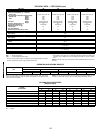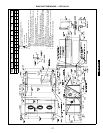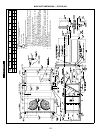171
GUIDE SPECIFICATIONS — 581C024-060 (cont)
2. Testing:
a. Evaporator and condenser coils shall be quali-
fied to UL 1995 burst test at 2,200 psi.
b. Evaporator and condenser coils shall be leak
tested to 150 psig and pressure tested to 400
psig.
3. Optional Coils:
a. Optional pre-coated aluminum-fin coils shall
have a durable epoxy-phenolic coating to pro-
vide protection in mildly corrosive coastal envi-
ronments. Coating shall be applied to the
aluminum fin stock prior to the fin stamping pro-
cess to create an inert barrier between the alu-
minum fin and copper tube. Epoxy-phenolic
barrier shall minimize galvanic action between
dissimilar metals.
b. Copper-fin coils shall be constructed of copper
fins mechanically bonded to copper tubes and
copper tube sheets. Galvanized steel tube
sheets shall not be acceptable. A polymer strip
shall prevent coil assembly from contacting the
sheet metal coil pan to minimize potential for
galvanic corrosion between coil and pan. All
copper construction shall provide protection in
moderate coastal environments.
c. E-Coated aluminum-fin coils shall have a flexible
epoxy polymer coating uniformly applied to all
coil surface areas without material bridging
between fins. Coating process shall ensure
complete coil encapsulation. Color shall be high
gloss black with gloss — 60 deg of 65 to 90%
per ASTM D523-89. Uniform dry film thickness
from 0.8 to 1.2 mil on all surface areas including
fin edges. Superior hardness characteristics of
2H per ASTM D3363-92A and cross-hatch
adhesion of 4B-5B per ASTM D3359-93. Impact
resistance shall be up to 160 in.-lb (ASTM
D2794-93). Humidity and water immersion resis-
tance shall be up to minimum 1000 and 250
hours respectively (ASTM D2247-92 and ASTM
D870-92). Corrosion durability shall be con-
firmed through testing to be no less than 1000
hours salt spray per ASTM B117-90. Coil con-
struction shall be aluminum fins mechanically
bonded to copper tubes.
d. E-Coated copper-fin coils shall have a flexible
epoxy polymer coating uniformly applied to all
coil surface areas without material bridging
between fins. Coating process shall ensure
complete coil encapsulation. Color shall be high
gloss black with gloss — 60 deg of 65 to 90%
per ASTM D523-89. Uniform dry film thickness
from 0.8 to 1.2 mil on all surface areas including
fin edges. Superior hardness characteristics of
2H per ASTM D3363-92A and cross-hatch
adhesion of 4B-5B per ASTM D3359-93. Impact
resistance shall be up to 160 in.-lb (ASTM
D2794-93). Humidity and water immersion resis-
tance shall be up to minimum 1000 and 250
hours respectively (ASTM D2247-92 and ASTM
D870-92). Corrosion durability shall be con-
firmed through testing to be no less than 1000
hours salt spray per ASTM B117-90. Coil con-
struction shall be copper fins mechanically
bonded to copper tubes with copper tube
sheets. Galvanized steel tube sheets shall not
be acceptable. A polymer strip shall prevent coil
assembly from contacting sheet metal coil pan
to maintain coating integrity and minimize corro-
sion potential between coil and pan.
F. Heating Section:
1. Induced-draft combustion type with energy saving
direct-spark ignition system and redundant main
gas valve.
2. Heat Exchanger:
a. The standard heat exchanger shall be of the
tubular-section type constructed of a minimum
of 20-gage steel coated with a nominal 1.2 mil
aluminum-silicone alloy for corrosion resistance.
b. The optional stainless steel heat exchanger
shall be of the tubular-section type, constructed
of a minimum of 20-gage type 409 stainless
steel.
3. Burners shall be of the in-shot type constructed of
aluminum-coated steel.
4. All gas piping shall enter the unit cabinet at a single
location on side of unit (horizontal plane).
5. The integrated gas controller (IGC) board shall
include gas heat operation fault notification using an
LED (light-emitting diode).
6. Unit shall be equipped with anti-cycle protection
with one short cycle on unit flame rollout switch or 4
continuous short cycles on the high-temperature
limit switch. Fault indication shall be made using an
LED.
7. The IGC board shall contain algorithms that modify
evaporator-fan operation to prevent future cycling
on high-temperature limit switch.
8. The LED shall be visible without removal of control
box access panel.
G. Refrigerant Components:
Refrigerant circuit components shall include:
1. Fixed orifice metering system (Acutrol
TM
device).
2. Refrigerant filter drier.
3. Service gage connections on suction, discharge,
and liquid lines.
H. Filter Section:
1. Standard filter section shall consist of factory-
installed, low velocity, throwaway 2-in. thick fiber-
glass filters of commercially available sizes.
2. Filter face velocity shall not exceed 320 fpm at nom-
inal airflows.
3. Filter section should use only one size filter.
4. Filters shall be accessible through an access panel
with “no-tool” removal.
I. Controls and Safeties:
1. Unit Controls:
Unit shall be complete with self-contained low-volt-
age control circuit protected by a fuse on the 24-v
transformer side.
2. Safeties:
a. a.Unit shall incorporate a solid-state compressor
protector which provides anti-cycle reset capa-
bility at the space thermostat, should any of the
following standard safety devices trip and shut
off compressor.
1) Compressor overtemperature, overcurrent.
2) Loss-of-charge/low-pressure switch.
3) Freeze-protection thermostat, evaporator
coil.
4) High-pressure switch.
5) Automatic reset motor thermal overload
protector.



